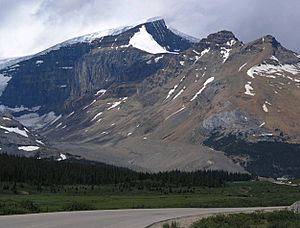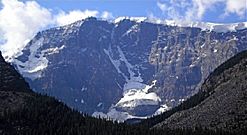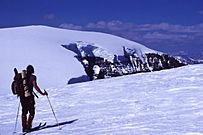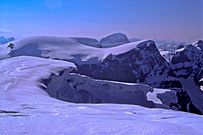Mount Kitchener facts for kids
Quick facts for kids Mount Kitchener |
|
|---|---|

Mt. Kitchener at dawn from the Icefields Parkway
|
|
| Highest point | |
| Elevation | 3,505 m (11,499 ft) |
| Prominence | 280 m (920 ft) |
| Listing | Mountains of Alberta |
| Geography | |
| Parent range | Winston Churchill Range |
| Topo map | NTS 83C/03 Columbia Icefield |
| Climbing | |
| First ascent | 1927 by Alfred J. Ostheimer, guided by Hans Fuhrer |
| Easiest route | rock/snow climb |
Mount Kitchener is a large mountain found in the Columbia Icefield. This icefield is a huge area of ice and snow in Jasper National Park, which is part of the Canadian Rockies. You can easily spot Mount Kitchener from the Icefields Parkway (Highway 93) when you are near Sunwapta Pass.
The mountain was first named Mount Douglas by J. Norman Collie. He named it after David Douglas, a famous plant scientist. In 1916, the mountain's name was changed to Mount Kitchener. This new name honored Lord Kitchener, who was a very important British soldier and leader. He had just died during World War I.
Contents
Climbing Mount Kitchener
Mount Kitchener is a popular spot for climbers. The first people to reach the top were Alfred J. Ostheimer and his guide, Hans Fuhrer, in 1927.
Popular Climbing Routes
Climbers use different paths, called routes, to get to the top. Some common routes include:
- SouthWest Slopes (Normal Route) I
- Grand Central Couloir V 5.9
- Ramp Route V 5.8
Notable Ascents
Over the years, some very impressive climbs have happened on Mount Kitchener. One famous climb was the Grand Central Couloir route. Jeff Lowe and Michael Weis completed this challenging climb in August 1975.
Discovering Mount K2
Mount K2 is a peak near Mount Kitchener. It stands at 3,090 meters (about 10,138 feet) tall. Rex Gibson, who used to be the president of the Alpine Club of Canada, named Mount K2 in 1938. He likely chose the name K2 to show that it was a smaller, but still important, peak connected to Mount Kitchener.
Weather at Mount Kitchener
Mount Kitchener is in a subarctic climate zone. This means it has very cold and snowy winters. The summers are usually mild. Temperatures can drop below -20 degrees Celsius (-4 degrees Fahrenheit). With the wind, it can feel even colder, sometimes below -30 degrees Celsius (-22 degrees Fahrenheit).
Gallery







